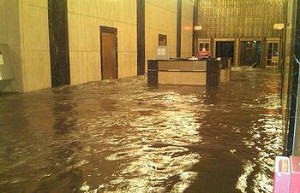Water. Damage. Those two words have the potential to become a major source of liability for both facilities managers and restoration companies if not properly handled.
For example, water loss in a high-rise condominium in Denver, Colo., originated on the seventh floor and grew in scope as it spread to units three floors below. While water damage in a single-family home is challenging enough, adding multiple floors increases the possibility of additional contamination and exposure (health and legal) for all concerned.
The first consideration in any water loss is the source of the water, followed closely by the materials through which the water flows. In commercial buildings, the risk can grow exponentially because much of the building’s interior cannot be easily inspected with the naked eye. Unknown hazardous building materials adds to the mystery that water damage presents.
The water source will determine how the situation should be addressed. The water could possess contaminants that are harmful to occupants. Raw sewage is one obvious type of dangerous water source, but many others exist that require certain protocols for the removal and replacement of affected materials to protect the health of the occupant.

Lobby of 140 West St. in New York City inundated with floodwaters from Hurricane Sandy. (Photo courtesy Governor Andrew Cuomo)
In the case of the high-rise building, the water had flowed through several stories, and the restoration company had to assume the potential exposure was high to ensure the tenant’s safety. The composition of the materials in the building was mostly unknown. Asbestos was in some of the drywall, but any number of dangerous pathogens could have existed in the structure.
Protocols for water damage restoration are established by the Institute of Inspection, Cleaning and Restoration Certification (IICRC). Most major insurance companies recognize the IICRC standards and follow them to establish a scope of repairs with professional restoration contractors.
This particular loss, however, was unique, and the IICRC guidebook did not address the complicated nature of the situation. After discussions with industry experts, one of whom wrote parts of the guidebook, it was concluded that commercial buildings with multiple floors are gray areas for water losses. When gray areas occur, property losses become complicated for everyone involved. Property owners and managers want their units restored to prior condition without unnecessary expense, insurance carriers want to minimize legal liability while controlling costs and professional restoration contractors want to ensure all parties (including their own company) are not subject to damage claims years down the road.
However, what cannot be seen cannot be properly addressed. As in this loss (an approach with which both property managers and insurance companies agreed), the property owner must be protected from any potential litigation and the occupant must be protected from any potential health hazard. In other words, when you cannot visually inspect building materials, assume the worst and proceed accordingly – even if that means prolonged restoration time and increased expenses.
Water losses can be extremely frustrating for property owners, facilities managers and restoration companies simply because often times no one knows what might be hidden behind the walls. Going for a simple solution may save a few dollars today, but expose everyone to huge liability claims later.
Michael Mastous
Michael Mastous is president of Delta Disaster Services of Denver, a full-service restoration company, that provides mitigation and reconstruction for water damage, fire/smoke damage and mold/mildew issues.


